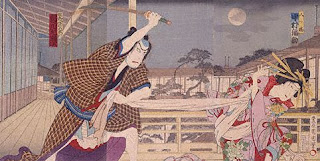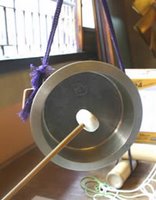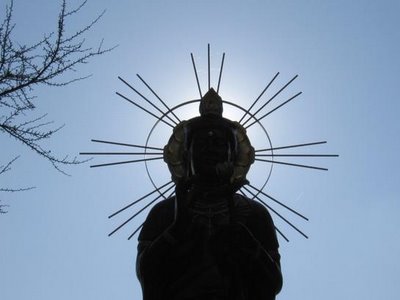[ . BACK to WORLDKIGO TOP . ]
:::::::::::::::::::::::::::::::::::::::::::::::::::::::::::::::::::::::::::::::::::::::::::::::::::
Day of Gioo the Dancer (Gioo Ki)
***** Location: Japan
***** Season: Mid-Spring
***** Category: Observance
*****************************
Explanation
Memorial Day for Gio, the mistress of Kiyomori
Gioo Ki 妓王忌 (ぎおうき)
Gioo Ki 祗王忌(ぎおうき)
:::::::::::::::::::::::::::::::::::::::::::::::::::::::::::::::::::::::::::::::::::::::::::::::::::::
Giō and Hotoke
The story of Giō and Hotoke is long and involved, but basically tells of the most famous shirabyoshi Giō, who had won the heart of
Taira no Kiyomori, being ousted by a younger and more talented shirabyoshi named Hotoke. Kiyomori cruelly sent Giō away, which grieved her greatly, and Hotoke was constantly ridden with guilt.
A year later, Giō was asked to perform a dance for Hotoke at Kiyomori's command, who actually intended on humiliating her. In her grief and humiliation, Giō, her sister and their mother became nuns seeking for a happier life. A few years later, the guilt was too great for Hotoke and she became a nun. She asked for forgiveness from Giō, who willingly forgave her and the four women lived out the rest of their days in prayer.
Shirabyoshi (白拍子)
were female dancers that performed traditional Japanese dances (also called "shirabyoshi") dressed as men. The profession of shirabyoshi developed in the 12th century. They would perform for nobles and high-ranking samurai, and at celebrations.
They are sometimes referred to as courtesans in the West, but the term refers to a high-class prostitute, so this is rather incorrect. By nature they were performers, though some shirabyoshi would give birth to nobles' children, but this was not their purpose.
Shizuka, a famous shirabyooshi, commonly referred to as
Shizuka-gozen, was the concubine and lover of Minamoto no Yoshitsune, the tragic hero of many folk legends.
© More in the WIKIPEDIA !

Dolls:
Gio and her younger sister Gijo
祗王とその妹の祗女
............................. The song of Dancer Hotoke
"A delicate young pine at her first meeting
With him who is her Lord, through joys and tears
Sings of her hope that he may hear the beating
Wings of the passage of a thousand years;
While storks upon the tortoise island stand
And crowd the lily pond to seek his hand."
Read all the details here
THE STORY OF GIO
.......................................................................
 shirabyooshi 白拍子 Shirabyoshi Clay Doll
shirabyooshi 白拍子 Shirabyoshi Clay Doll
34 cm high
. Dolls from Shimane 島根県 .
Nagahama 長浜土人形 clay dolls
*****************************
Worldwide use
*****************************
Things found on the way
 Taira Kiyomori and the Genpei War
*****************************
Taira Kiyomori and the Genpei War
*****************************
HAIKU
妓王忌のミッキーミニーのペアカップ
Gio ki no mikkii minii no pea kappu
Gio Day -
pair cups of
Mickey and Minnie
© Gendai Haiku Kukai

Japanese are very fond of
pair cups. Usually, they are called "Couple's cups"
meoto yunomi 夫婦湯のみ for husband and wife. Now boyfriends and girlfriends use them when they live together. Usually the one for the wife is just a bit smaller.
We also have rice bowls for couples in the same way.
Click on this thumbnail to view some more samples.
 Traditional Tea cups for Couples
Traditional Tea cups for Couples
More about Happy Couples (meoto, fuufu) in Japan :
Meoto Daruma and the Takasago Legend 夫婦だるま
:::::::::::::::::::::::::::::::::::::::::::::::::::::::::::::::::::::::::::::::::::::::::::::::::::::
妓王忌の苔に結べる春の露
香燿子
妓王忌や屈託もなく若き声
Gioo Ki ya kuttaku mo naku wakaki koe
Gio Memorial Day -
this young voice
so carefree
君不去
Tr. Gabi Greve
妓王忌とおもふ渚のうつぼ草
吉田紫乃
:::::::::::::::::::::::::::::::::::::::::::::::::::::::::::::::::::::::::::::::::::::::::::::::::::::
 - quote -
Dancer, Nun, Ghost, Goddess
- quote -
Dancer, Nun, Ghost, Goddess
The Legend of Giō and Hotoke in Japanese Literature, Theater, Visual Arts, and Cultural Heritage
Roberta Strippoli, Binghamton University
Dancer, Nun, Ghost, Goddess
explores the story of the dancers Giō and Hotoke, which first appeared in the fourteenth-century narrative Tale of the Heike. The story of the two love rivals is one of loss, female solidarity, and Buddhist salvation. Since its first appearance, it has inspired a stream of fiction, theatrical plays, and visual art works. These heroines have become the subjects of lavishly illustrated hand scrolls, ghosts on the noh stage, and Buddhist and Shinto goddesses. Physical monuments have been built to honor their memories; they are emblems of local pride and centerpieces of shared identity.
Two beloved characters in the Japanese literary imagination, Giō and Hotoke are also models that have instructed generations of women on how to survive in a male-dominated world.
- source : brill.com/products/book... -
:::::::::::::::::::::::::::::::::::::::::::::::::::::::::::::::::::::::::::::::::::::::::::::::::::::
- quote -
Temple Gio-Ji - The Ladies’ Temple in Saga
- snip -
... I discovered a Basho renku about the Nonomiya Shrine in Saga, west of Kyoto, ...
... I translate
“Gio dera” to “ladies’ temple” in a stanza by
Basho taken from linked verse, known as renga.
Her hair gone,
chamberlain’s daughter
grown weary
Storm over Nonomiya
ladies’ temple bells
The Grand Chamberlain (Jijū) is a chief functionary of the Imperial court, and aide to the Emperor of Japan. He also keeps the Privy Seal and the State Seal, but his high rank does not prevent his daughter from experiencing the travails of life. She cuts her hair and escapes to Saga, at the foot of Mount Arashi (Storm Mountain) where there are many temples. Because “Gio” sounds like “Gion,” the stanza in Japanese recalls the famous opening to the Tales of the Heike:
“The bells of the Gion Shōja echoes the impermanence of all things…. The proud do not endure, like a dream on a spring night, the mighty falls at last, as dust before the wind.”
The Gion Shōja (or
Jetavana) temple in India is where the Buddha gave most of his discourses. This passage is usually said to portray the fall of Kiyomori and his clan from power and wealth to exile and death – however the words well apply to the tale of the four dancers who became four nuns.
Basho sets up the opposition of storm and bells. The first is wild, violent, uncaring; the second deep, steady, and unifying. The storm represents the arrogance and intimidating behavior of men such as Kiyomori; the bells are the steady, focused energy of women. A bell, shaped like a uterus, is clearly female. Temple bells, with their reverberations of up to a full minute, are conducive to meditation, and have become a symbol for world peace. “Bells,” as final word of the verse, resounds through the weariness of the daughter as well as the violence of the storm. In “bells” there is resolution.
When I visited Gio-ji, I spoke to a priest who pointed out that the temple has no bell, so in Basho’s stanza we hear the bells of many temples in Saga combining their reverberations. While Gio-ji lacks a bell, it does have a beautiful moss garden which you can walk through but not touch. The temple is a twenty minute walk from Arashiyama Station which is a fifteen minute ride on the JR Sagano Line from Kyoto Station. There are statues of the four women, and their graves; they remained together for eternity. Maybe if you are there in the evening, you will be able to hear the kindness of Gio, the wisdom of Lady Buddha, the solidarity of the four women, in the temple bells of Saga. Furthermore, through this renku pair, we can explore the multi-faceted issue of gender politics, the ways men use their power to dominate women, the adaptations of women to survive, the chamberlain’s daughter who seems to be alone in her weariness, the ladies who found happiness in sharing their lives of devotion.
- source : Jeff Robbins 2017 -
Giō-ji 祇王寺 Temple Gio-Ji
Kyoto, Ukyō-ku, Sagatoriimoto Kozakacho, 32

... Tiny Gio-ji Temple is one of the most scenic spots in Arashiyama. The thatched-roof main hall overlooking a moss-covered grotto is a magical sight.
. Matsuo Basho Archives 松尾芭蕉 .
*****************************
Related words
*****
Memorial Days of Famous People
....... A WORLDWIDE SAIJIKI
:::::::::::::::::::::::::::::::::::::::::::::::::::::::::::::::::::::::::::::::::::::::::::::::::::::::::::::::::::::::::::
[ . BACK to DARUMA MUSEUM TOP . ]
[ . BACK to WORLDKIGO . TOP . ]
- #gioji -
:::::::::::::::::::::::::::::::::::::::::::::::::::::::::::::::::::::::::::::::::::::::::::::::::::::::::::::::::::::::::::









































